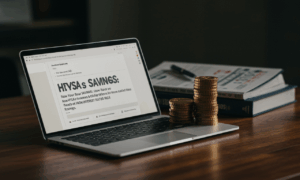Negative Interest: What It Is and How It Can Affect Your Savings
Imagine a world where you have to pay a bank to hold your money. It sounds counterintuitive, going against everything we have learned about saving. Normally, you deposit your funds and earn interest, a small reward for your diligence. However, in certain economic climates, the concept of negative interest rates flips this fundamental principle on its head. This isn’t a far-fetched theory; it’s a real-world policy that has been implemented by several central banks around the globe. Understanding this complex financial tool is no longer just for economists; it’s crucial for anyone looking to protect and grow their personal savings. This article will demystify negative interest rates, explain why they exist, and most importantly, provide you with actionable strategies to navigate their impact on your finances.
What Exactly Are Negative Interest Rates?
In the simplest terms, a negative interest rate means that depositors are charged a fee for keeping their money in a bank account, instead of receiving interest payments. Think of it as a storage fee for your cash. The central bank of a country charges commercial banks for holding their excess reserves, and in turn, commercial banks may pass this cost on to their corporate and, in some cases, retail customers. The rate is typically a small percentage, but its implications are enormous.
This policy is a form of unconventional monetary policy. Traditionally, central banks lower interest rates to encourage borrowing and spending to stimulate the economy. When rates are already near zero and the economy still needs a boost, a central bank might push them into negative territory. This is a deliberate move designed to penalize hoarding cash and incentivize a more active flow of money throughout the financial system.

Why Would a Central Bank Implement Such a Policy?
The decision to introduce negative interest rates is never taken lightly and is usually a response to significant economic challenges. There are two primary motivations behind this strategy:
- To Stimulate Economic Growth: When banks are charged for holding reserves, they have a strong incentive to lend that money out to businesses and individuals. This increased lending can fuel investment, expansion, and consumer spending. The goal is to make holding cash unattractive, thereby pushing money out into the productive economy where it can generate activity and growth.
- To Combat Deflation: Deflation is a persistent decrease in the general price level of goods and services. It can be incredibly damaging to an economy because consumers delay purchases, expecting prices to fall further. This reduces demand, leading to lower production, job losses, and a downward economic spiral. By making saving costly, negative interest rates encourage people to spend or invest their money now, helping to increase demand and push prices up, or at least stabilize them.
How Negative Interest Can Directly Affect Your Savings
The most direct impact of a negative interest rate policy, or NIRP, is on the value of your cash savings. If your bank decides to pass on the negative rate to your deposit account, your balance will gradually decrease over time, even if you do not make any withdrawals. For example, with a -0.5% interest rate, a €10,000 deposit would shrink to €9,950 after one year, not accounting for any other bank fees.
This forces a fundamental shift in how you must think about money. Cash, traditionally seen as the safest asset, becomes a depreciating one. This erosion of capital can be especially concerning for retirees or anyone relying on savings for income or security. It challenges the very idea of a risk-free return and compels savers to consider alternatives they might have previously avoided.
Strategies to Protect Your Wealth in a Negative Interest Environment
While the prospect of paying to save is unsettling, it does not mean your financial goals are unattainable. It simply means you must adapt your strategy. Instead of being passive, you need to become more active in managing your money. Here are several practical steps you can take:
- Diversify Your Assets: The old adage do not put all your eggs in one basket is more relevant than ever. Holding too much cash in a bank account becomes a liability. Spreading your capital across different asset classes can mitigate risk and open up opportunities for growth.
- Explore Investment Opportunities: To counteract the eroding effect of negative rates, you need to find assets that can generate a positive return. This might mean increasing your exposure to the stock market, investing in corporate or government bonds, or considering real estate. A well-diversified investment portfolio is a key defense.
- Pay Down High-Interest Debt: One of the most effective ways to get a guaranteed return on your money is to pay off debt. If you have credit card debt with an 18% annual interest rate, using your excess cash to clear that balance is equivalent to earning an 18% return on that money. It is a financially sound move in any interest rate environment, but especially in a negative one.
- Consider Longer-Term Fixed Deposits: While demand deposit accounts may be subject to negative rates, banks might still offer positive, albeit low, interest on fixed-term deposits or certificates of deposit (CDs). By locking your money away for a specific period, you may be able to secure a modest positive yield.
- Seek Professional Advice: Navigating a complex financial landscape like this can be challenging. Consulting with a qualified financial advisor with demonstrable experience can provide you with a personalized strategy tailored to your risk tolerance and financial objectives.
Conclusion: A New Paradigm for Savers
Negative interest rates represent a significant departure from traditional economic norms. They are a powerful tool used by central banks to fight economic stagnation and deflation, but they come with direct consequences for savers. The era of earning a modest, risk-free return simply by parking cash in a savings account may be challenged in such environments. However, this does not spell doom for your financial future. Instead, it serves as a call to action. By understanding the mechanisms at play and adopting a proactive, diversified approach to managing your wealth, you can not only protect your savings but also position yourself to thrive in this evolving financial world. The key is to stay informed, think strategically, and make your money work for you, rather than paying for it to sit idle.
Frequently Asked Questions (FAQ)
Can my regular checking account balance go down due to negative interest rates?
Yes, it is possible. While many banks have been hesitant to apply negative rates directly to small retail depositors due to public relations concerns, it is not out of the question. Some banks in affected countries have already applied them to accounts with large balances, typically those held by corporations or wealthy individuals. It is crucial to read the terms and conditions of your bank account to understand its policy on interest rates.
Are negative interest rates a common policy?
They are not common, but they are no longer purely theoretical. The European Central Bank, the Bank of Japan, and the central banks of Denmark, Sweden, and Switzerland have all implemented negative interest rate policies at various times to address their specific economic challenges. It remains an unconventional tool reserved for extraordinary economic circumstances.
What is the ultimate goal of a central bank when it implements this policy?
The primary objective is to stimulate the economy. By making it costly for commercial banks—and by extension, consumers and businesses—to hoard cash, the central bank aims to encourage more lending, spending, and investment. This increased economic activity helps to boost growth, create jobs, and prevent or combat the harmful effects of deflation.



